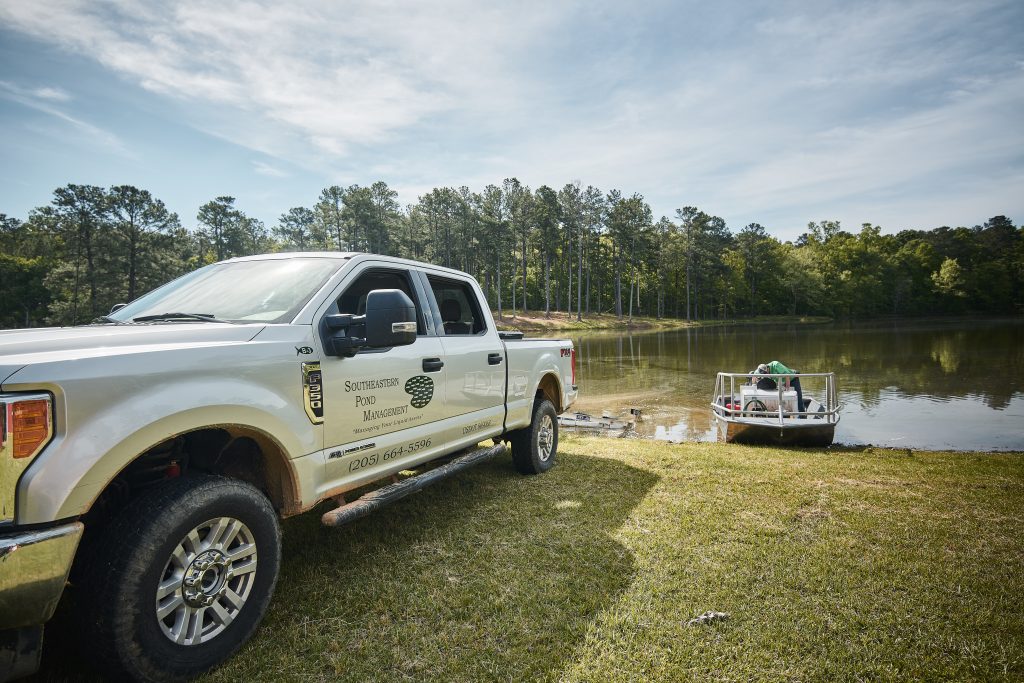Whether you decide to manage your pond for general recreation or cultivate it for trophy bass fishing, you need to have a plan. That entails a written definition of what you want to accomplish and how you are going to do that and, if you truly want the best results, it makes sense to work with pond management professionals.
Norman Latona is founder and president of Southeastern Pond Management based out of Birmingham, Alabama. SEPond offers a plethora of pond and lake related services, including ecosystem analysis, management programs, liming, fertilizing, electroshocking, fishing stock inventory analysis and removal processes, stocking of forage and game fish, aquatic weed control and more.
According to Latona, there are a number of “input cornerstones” required for good lake and pond management and they are listed below.
#1 – Pond Evaluation
The very first thing that is required is to do an overall assessment of the physical scenario of the pond and its infrastructure.
A pond is a “physical plant” and over time, it will show signs of aging and deterioration.
Latona emphasized that it is important to make sure that your dams are safe and that there are no channels or ditches undercutting the foundation. In addition, make sure it is absolutely free of woody vegetation in the front, top and back sides and the reason is roots.
“While woody vegetation and the subsequent roots anchor the soil to some extent and help prevent erosion, they can severely tunnel underneath and even into the dam and if a storm knocks down that tree suddenly you have a big hole that most likely will fill with water and possible result in structural problem,” Latona said. “You want the sides, top and back of the dam to be free of woody vegetation and have the right slope to be able to use a bush hog or other equipment to keep things cut or, if necessary, you can use herbicides”.
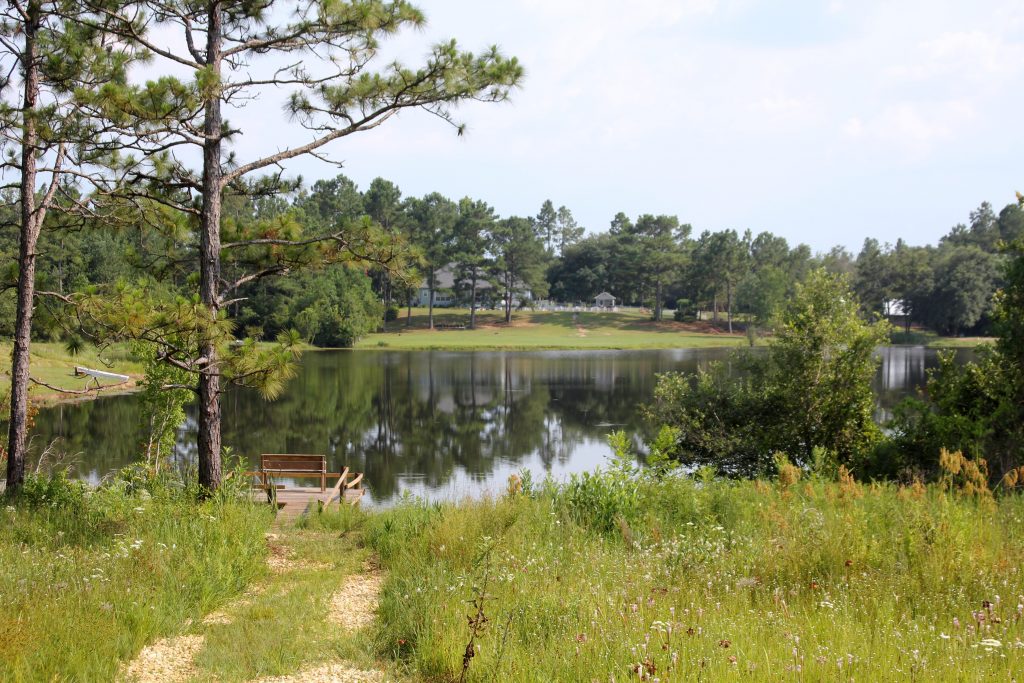
#2 – Fishing Population and Health Inventory
Depending on the objectives and goals of the pond owner it makes sense to do an inventory of the fish population. That is where electroshocking comes into play. It gives SEPond an idea as to the vitality of the fish population and overall health and provides a base on which to develop a pond management plan. For example, if the pond is “predator crowded” and the majority of the bass are skinning and undersized, it may require removing some of the bass to bring the predator and forage fish population back into a healthy balance.
#3 – Liming and fertilizing
Liming is a critical and foundational step that can have a huge impact on water quality and appearance, especially as it relates to fish production.
Latona pointed out that all that is needed to test for alkalinity is a simple water test.
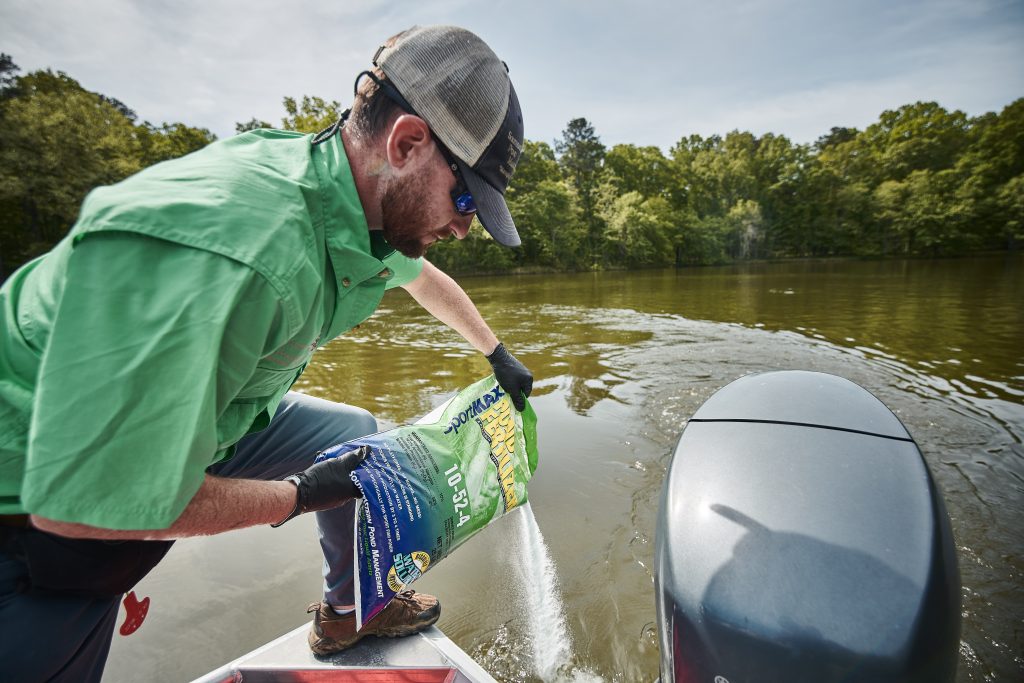
“It is a simple test and we will even come out and do the test for you,” Latona said. “Based on the results we can give you a good idea as to how much lime you need to put in and it’s based on tons per acre.”
Alkalinity is water’s ability to resist changes in pH and is a measure of the concentration elements like carbonates, bicarbonates, hydroxides, phosphates and borates. Liming increases pH, which can help the water to clear suspended particles (as in mud) and can help initiate plankton life and growth by increasing light. It increases nutrients, specifically phytoplankton which is the base of the food chain in fish ponds and results in rapid fish growth and survival.
Since lime is a rock, it takes time to disperse so it only has to be done once every three or four years. While lime isn’t very expensive, delivery cost is a consideration.
“The cost of transportation with dump trucks, depending on the distance involved, nowadays can cost as much as the material itself so it makes sense to lime for a longer period of time,’ Latona said. “If you need one ton per acre annually, you should consider doing three to four tons per acre every three to four years.”
The next pond management step is fertilizing. Once the pH is in sync, fertilizing allows for the growth of planktonic algae that constitutes the base for the pond food chain.
“Fertilization is almost always beneficial…it boosts baseline production by 300-400%,” Latona said.
#4 – Supplemental Stocking
Supplemental stocking is frequently indicated, most often to bolster the forage fish community. The most common forage species to stock include bluegill, threadfin shad, tilapia, crawfish, and golden shiners
“The more secure and abundant the food source, the faster the bass are going to grow. When I say forage fish, I’m talking about everything from bluegill to shellcrackers, fathead minnows, golden shiners and even threadfin shad,” Latona said. “Typically, the bluegill that we stock are in the one-to-three-inch size range and the ideal forage stocking timeline is from early fall all the way to late winter.”
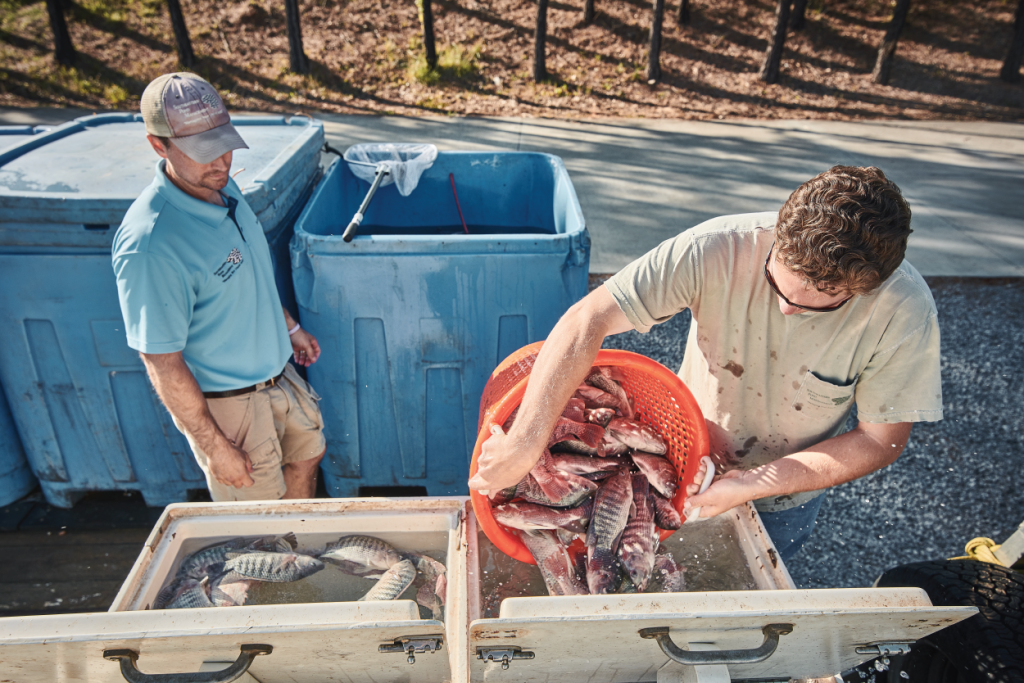
How many forage fish and largemouth bass should you stock?
According to Latona the time-honored pond management standard is approximately 10 forage fish to one predator per acre, which is a 10 to 1 ratio. That can change depending on what the pond owner wants to accomplish. If the goal is to produce trophy bass, Latona may cut down on the number of bass stocked or substantially increase the number of forage fish to make sure that those bass that are stocked have plenty to eat for maximum weight gain. On the other hand, if the goal is to ensure a bunch of respectable medium size bass to catch the ratio of bass introduced may increase as well as the forage fish at the beginning of the pond restoration process.
#5 – Aquatic vegetation control
Sometimes weeds and aquatic vegetation can get out of control and literally take over the pond. Aquatic Herbicides can solve this issue.
In addition to herbicides there are other more organic ways to control a pond’s vegetation inventory. Latona explained that most aquatic nuisance plants have their origins in the mud in the bottom of the pond and need sunlight to develop and grow. Consequently, by coloring the water by liming and fertilizing and limiting the amount of sunlight that penetrates down into the water column to the mud, that alone inhibits aquatic weed growth.
“While it sounds counterintuitive to fertilize in order to stop weed growth, what we are attempting to do is grow planktonic algae in the water that give a pond that green tip and reduce sunlight penetration and stop weed growth.” Latona said. “That actually adds up to a giant shade cloth over the pond and cuts down on the visibility and sunlight penetration to the bottom.”
Introducing grass carp can also help solve the issue.
“Grass carp are not going to completely eradicate aquatic vegetation unless you stock them at a super high density, but they are a piece of the puzzle and part of the strategic solution,” Latona added.
#6 – Supplemental Forage Fish Feeding
Supplemental forage fish feeding is a useful and productive pond management input aimed at providing a nutritional boost to the bluegill, as well as concentrating them into an area, making them easier to catch and can produce some lunkers. The healthier the bluegills are, the more they will reproduce and that means more fry for bass to eat. Texas Hunter has a full line of fish feeders.
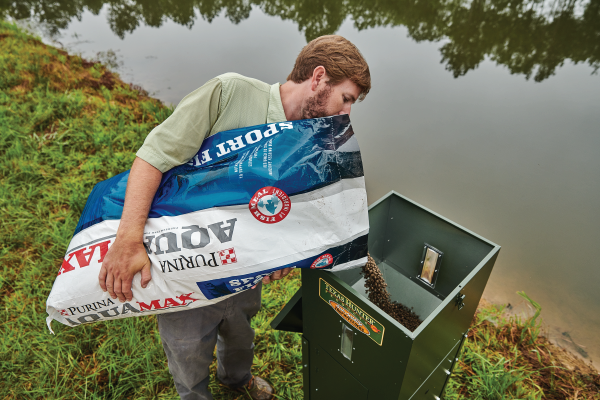
#7 – Fish Habitat
Bass need a place to hang out where they feel protected, provides shade and serves as a hideout to ambush forage fish and the more structure the better. You can sink logs, brush, Christmas trees, concrete riprap etc, but whatever structure you sink in your pond won’t last forever.
“There are a number of viable options that have been created by various companies that are artificial elements, artificial structure that look like trees, bushes and other vegetation with limbs and they are fairly economical and last forever,” Latona said.
“Texas Hunter has some amazing stuff like lily pads that float on the surface to simulate lily pads and create top water fishing along with a bottom anchored fish pyramid that provide structure and shade,” Latona pointed out.” They have got grasses and leafy items that are designed to deploy and sink to the bottom and they last a long time.”
“We get heavily involved in developing a planned habitat design and then going out and installing the product and they last for a long time,” he added.

